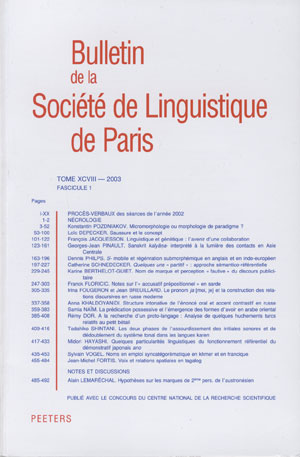 previous article in this issue previous article in this issue | next article in this issue  |

Preview first page |
Document Details : Title: Le zêtacisme éléen Subtitle: Z pour *d dans les inscriptions éléennes dialectales: trait phonétique ou graphique? Author(s): MINON, Sophie Journal: Bulletin de la Société de Linguistique de Paris Volume: 93 Issue: 1 Date: 1998 Pages: 181-210 DOI: 10.2143/BSL.93.1.2002493 Abstract : Le zêtacisme éléen: Z pour *d dans les inscriptions éléennes dialectales: trait phonétique ou graphique? Dans l'épigraphie grecque dialectale d'Olympie et de sa région, un tiers des inscriptions officielles datées entre ca 550 et ca 475/450 fait apparaître Ζ pour *d, à la place de Δ, tandis que le produit de *dj, de *g(w)j et d'une partie des *j initiaux est généralement noté Δ. Comme il est très vraisemblable que la lettre Ζ fut adoptée avec le reste de l'alphabet éléen pour noter initialement le stade palatalisé, encore distinct de (d)d, de l'évolution de *dj, on s'est demandé si le remploi de cette lettre pour *d n'indiquait pas la palatalisation de ce dernier phonème, plutôt que sa spirantisation, dont on avait fait le plus souvent l'hypothèse. Cependant, la difficulté de l'une et de l'autre de ces explications conduit à leur préférer une solution graphique. Elan zetacism: Ζ for *d in the dialectal inscriptions: a phonetic or a graphic feature? In the Greek dialectal epigraphy from Olympia and the surrounding area, one third of the public inscriptions dating from ca 550 to ca 475/450 shows Ζ instead of Δ, for *d; at the same time, the outcome of *dj, *g(w)j and part of initial *j is generally transcribed with Δ. As it is very likely that the letter Hwas adopted with the whole Elean alphabet to transcribe at first the palatal outcome of *dj, (d)d, still different from (d)d, I wondered if the Eleans made use of Hagain to represent, not /δ/, as it has been usually assumed, but rather /d'/. Both of these explanations being difficult, I tend to prefer yet a graphic solution. Eleischer Zetazismus: Ζ für *d in den eleischen dialektalen Inschriften: ein lautlicher oder ein graphischer Zug? In der dialektalen griechischen Epigraphik von Olympia und seiner Region erscheinen bei einem Drittel der offiziellen Inschriften, die zwischen ca. 550 und ca. 475/450 datiert werden, Ζ für *d anstelle von Δ, während das Resultat aus *dj, *g(w)j und eines Teils von *j am Wortanfang allgemein mit Δ wiedergegeben wird. Da es sehr wahrscheinlich ist, dass der Buchstabe Ζ mit dem Rest des elischen Alphabets übernommen wurde, um ursprünglich das palatale Stadium wiederzugeben, noch unterschieden von (d)d, welches aus *dj hervorgegangen ist, hat man sich gefragt, ob der Gebrauch dieses Buchstabens für *d nicht vielmehr die Palatalisierung dieses letzteren Phonems darstelle als eine Spirantisierung, wovon die meisten Hypothesen ausgehen. Die Schwierigkeit der einen wie der anderen dieser Erklärungen rät dazu, ihnen eine graphische Lösung vorzuziehen. |
|


